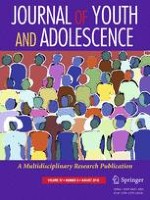30-06-2018 | Empirical Research
Experiencing and Learning About Emotions: A Longitudinal Analysis of Youth Program Participants
Gepubliceerd in: Journal of Youth and Adolescence | Uitgave 8/2018
Log in om toegang te krijgenAbstract
Organized youth programs provide a context where adolescents experience strong emotions and may develop new ways of thinking about and dealing with emotions. The current study examined youth’s reports of positive and negative emotions arising during the course of their work in different types of project-based programs; learning about emotions from different sources (e.g., from observing peers, interacting with adult staff, or engaging in self-reflection); and longitudinal associations between emotional experiences and learning. Quantitative data were collected at two time points from 319 youth (57% female; M age = 15.8 years; 33% Latino, 29% Black, 32% White, 6% other) participating in 14 Midwestern programs focused on Leadership, Arts and Performance (Arts), and Science, Technology, Engineering, and Math (STEM). Overall, positive emotions occurred more frequently than negative emotions, but emotional experiences differed based on the focus of the program. There were few significant differences in emotional learning from various sources (self, peers, staff) across the three types of programs. Multiple regression models controlling for prior learning indicated that, consistent with theory, positive emotions predicted subsequent learning about emotions from all sources. In contrast, negative emotions predicted increased learning from peers but decreased learning from self, suggesting that experiencing negative (vs. positive) emotions may lead youth to attend to different sources of information. The study’s findings have implications for theory, research, and practice.
